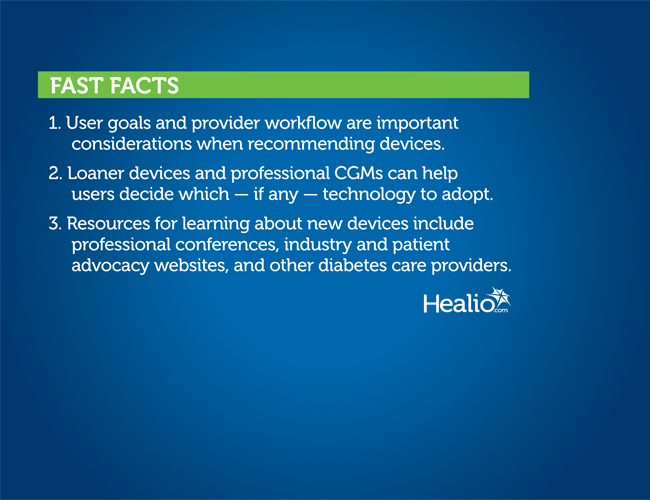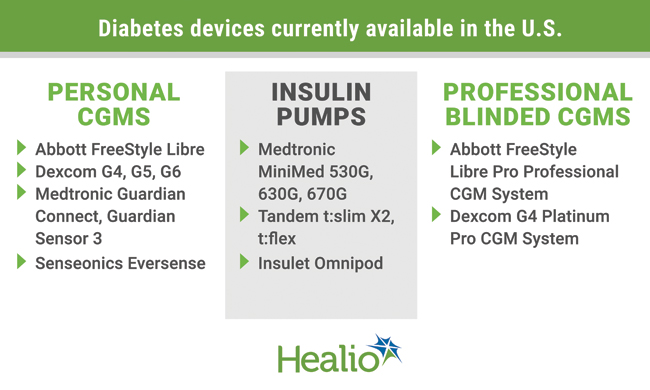As diabetes technologies advance, matching patients to the ‘right’ device challenges providers
Diabetes devices such as sensors, insulin pumps and continuous glucose monitors continue to improve, offering people with diabetes more opportunities for connected care. As a result, adoption of these technologies is gradually rising. Approximately 30% to 40% of people with type 1 diabetes and an increasing number of people with insulin-dependent type 2 diabetes are using pump and sensor technology, according to a 2018 review published in Diabetes Care. Another recent study shows CGM can be cost-effective for adults with diabetes when compared with the daily use of test strips and improves overall blood glucose levels while reducing hypoglycemia.
As new devices and updates for older technologies enter the market, endocrinologists, diabetes care and education specialists, and other providers can find themselves overwhelmed. Often, insulin pumps, “smart” meters and CGM, each with individual advantages, have limited interoperability. The result is a massive volume of patient data from multiple devices that leaves providers laboring to interpret numbers and troubleshoot with patients — all during an already limited visit.
Providers must find the best way to navigate available options and connect patients with the “right” devices for their specific needs.
“There is what the companies tell you these devices can do, and then there is what they actually do in the hands of a real, living patient,” Anne L. Peters, MD, professor of clinical medicine at Keck School of Medicine at the University of Southern California, Los Angeles, told Endocrine Today. “One of the big events of my existence was the 670G [hybrid-closed loop insulin-delivery system] from Medtronic, which looked great in the trials. When patients started using it, they found that living with it in real life was much harder. From my perspective — and what I always tell patients — I am only as good as my patients are in reporting to me their experience. This is such a patient-driven area. These are things they are wearing on their bodies 24/7.”

Source: WFBH Photography. Printed with permission.
Currently, two blinded CGM devices for professional use are available: the Abbott FreeStyle Libre Pro Professional CGM System and the Dexcom G4 Platinum Pro CGM System. Four companies have personal CGM devices on the U.S. market: Abbott (FreeStyle Libre), Dexcom (G4, G5, G6), Medtronic (Guardian Connect and Guardian Sensor 3) and Senseonics (Eversense). Three companies offer a variety of insulin pumps: Medtronic (MiniMed 530G, MiniMed 630G and MiniMed 670G), Tandem (t:slim X2 and t:flex) and Insulet (Omnipod). This year, the FDA cleared two of those pumps, the Omnipod DASH and the t:slim X2, to be marketed as integrated insulin pumps, allowing them to be part of an interoperable, automated insulin delivery system.
Endocrinologists must at least have a discussion about technology with all patients with diabetes, Joseph Aloi, MD, section chief for endocrinology and metabolism at Wake Forest Baptist Health in Winston-Salem, North Carolina, said in an interview.
“I’m always amazed when I come across someone I’ve been seeing for 10 years who just wasn’t aware of the technology that can assist with managing their diabetes,” Aloi told Endocrine Today. “Now, they may self-select, they don’t want to wear a device. That is the most common reason. I’ll show my patients or have them wear a loaner device, and they’ll come back and say, ‘I understand how meals affect my diabetes now.’ There is a little bit of getting the patients to buy in. If they’re not engaged, it is not going to work.”
Device abandonment
With so many options, providers can do much more to leverage available technology to improve clinical outcomes and better integrate devices into practices, according to Korey Hood, PhD, professor of pediatric endocrinology and staff psychologist at Stanford University School of Medicine.
“There’s a front end that we don’t do a great job on,” Hood, who has type 1 diabetes, told Endocrine Today. “Then once people are using a device, we do just kind of let them go. That is not the best way to do it. Periodic check-ins are good, but some people need more technology problem-solving.”

Often a person will begin using a particular CGM or pump — or both — without first understanding if the devices will fit their needs or lifestyle, Hood said.
“For example, if you are interested in preventing lows or getting alarms alerting you of lows, you will want certain devices over others,” Hood said. “There is not even that level of questioning of what the priorities are for the person with diabetes.”
That can lead to a common problem of device abandonment, he said. Data on how many people with diabetes opt to stop using technology vary. In a 2018 survey of T1D Exchange participants published in Clinical Diabetes, adult past users of CGM were asked to rate the importance of 21 possible reasons for abandoning the technology. The most frequently reported reasons involved obtrusiveness (discomfort, skin irritation, sensor change requirements and adhesive failure), cost and too-frequent alarms. Research presented this year at the Endocrine Society Annual Meeting showed that nearly 40% of first-time users of the MiniMed 670G hybrid closed-loop system stopped using the device within 9 months, with respondents citing technical difficulties as the main reason.
“We have a one-size-fits-all pace — here it is, go, come back in a couple weeks and we will reevaluate,” Hood said. “For some people, they just need to wear it for a day, get used to it and feel what it’s like. We need to ask the right questions that will then help people start from a more informed place and that gives them the best chance of sustaining use.”
Hood said once a person is using a system or device, periodic check-ins, either via phone or text message, are a simple way to learn whether a patient is having problems.
“There is no real data on this, but the longer you’ve had diabetes and lived with it successfully, it may be that you don’t feel you need additional help,” Peters said. “There has to be, in the patient, the true belief that the technology will improve them. Then the expectation has to be set with reality.”
Peters said many times there is a psychological component behind why a person with diabetes gives up on a device, particularly with the new closed-loop systems and DIY artificial pancreas systems.
“I have a ton of patients on the do-it-yourself system right now [incorporating the] Omnipod, and there are always the same phases,” Peters said. “There is the contemplation phase — should they do it or not? Then there is the fear phase of going on this new system, which is an incredibly different way of managing their diabetes. Then there is the adjustment phase, and then there is the phase of feeling liberated because you don’t have to worry about your nights. Finally, there is this phase of, ‘What the heck, I still have diabetes?’”

Peters often has to help these patients decide whether the system is really the right choice for them.
“I had a 16-year-old who was using Loop [a DIY artificial pancreas algorithm] for a couple of months, and she said Loop was still too much work.” Peters said. “I said, ‘Yes, Loop is work. It’s up to you and your parents to choose what is best for you.’ Her HbA1c was 6.5% before starting Loop and is 6.6% on Loop, so it didn’t change her blood sugar. For her, technology may or may not be helpful. My expectation of technology that works is, first and foremost, that it fits into a patient’s lifestyle. Technology doesn’t take away diabetes.”
On the pediatric side, adolescents may be self-conscious about using diabetes devices in school, which can draw unwanted attention, according to Jenise C. Wong, MD, PhD, associate professor of pediatrics in the division of endocrinology at the University of California, San Francisco. That can create a conflict between the adolescent and the parents or caregivers who may be pushing for device use, she said.

“In some cases, a parent may think, ‘Let’s put this sensor on, and we’ll get rid of lows,’ or ‘Let’s do hybrid closed-loop and every problem will be solved,” Wong told Endocrine Today. “While technology may theoretically reduce problems, for children, there is real-life that may get in the way.”
CGM alarms and alerts, as well as a need to use cellphones for diabetes-related apps, can set a child apart in the classroom, Wong said.
“Everyone wants to be normal,” Wong said. “It is hard on children if providers or parents say to them, ‘It’s not a big deal, no one cares if you are using your phone or a device for your diabetes,’ because that is a very adult perspective.”
‘Matching’ patients with technology
When matching a patient with the “right” diabetes technology, providers must consider the needs of the patient and the needs of their practice or clinic, according to Viral Shah, MD, assistant professor of medicine and pediatrics at the Barbara Davis Center for Diabetes and the School of Medicine at the University of Colorado Anschutz Medical Campus.
“I ask patients, what are their goals?” Shah said. “Some are more into sports and don’t like tubes, so something like the Omnipod is best. Others want integration with CGM. In that situation, you could select the Tandem Basal-IQ or a Medtronic system. Another patient concern is hypoglycemia fear. As providers and as a society, we focus so much on HbA1c, rather than why the patient has that HbA1c. Maybe they fear going low. For those patients, a system with a suspend-before-low feature is huge.”
Still other patients are concerned about multiple finger sticks, the size of the sensor or pump, and even the overall look of the device, Shah said.
“This can sound stupid, but people do care about the color or their pump or the size of their pump,” Shah said. “That’s a human factor. It’s beyond science. I have a patient in his mid-30s with a daughter who is 4 years old, and she uses a pump with a pink cover. She wants the father to use a pink cover, too, so both pumps look good. He does that, because he wants his daughter to use the same pump and improve her diabetes. Those minor things, we don’t study that in a rigorous way.”
Providers should also take into account the setup of their clinic and note how a specific device will fit into the busy office workflow, Shah said.
“For example, the Roche insulin pump, which is no longer available in the U.S., was so difficult to download,” Shah said. “It was not easy to use in a clinic and integrate into flow.”

Aloi said it is crucial to assess how willing a patient is to try a specific device and to understand that they might need some coaxing toward a decision.
“It’s not quite the nuclear option, but I’ll sometimes say, ‘As your endocrinologist, I can’t do any better without technology assisting,’” Aloi said. “Sometimes that gets people to take it from ‘This is something I could do,’ to ‘This is something my provider needs me to do.’ It is a process.”
Additionally, options like professional CGM or loaner devices can help a patient better understand what it feels like to live with a device, Aloi said.
“The nice thing is you don’t have to get married on the first date,” Aloi said. “There is technology you can try.”
Clearing up misunderstandings about how the devices work is also important, experts said.
“I cannot tell you how many people mistakenly thought that the sensor, every time it tested their blood sugar, was poking them every 15 minutes,” Aloi said. “They were thinking, ‘This doctor is crazy, he wants me to wear this on my arm? How am I going to sleep?’ I’ve had people who come to get their pump started and they fasted beforehand, thinking they were getting some sort of surgical procedure.”
How to keep up
As next generations of devices enter the market and closed-loop insulin delivery systems become more customizable, adoption rates among people with diabetes will likely increase, Hood said.
Currently, there is no resource endorsed by diabetes organizations that offers a comprehensive look at all available diabetes technology that is both updated in real time and available free to patients and providers. The American Diabetes Association publication Diabetes Forecast publishes an annual Consumer Guide to more than 150 diabetes tools, including meters, CGMs, pumps, infusion sets and insulin pens. In 2018, the American Diabetes of Diabetes Educators launched Diabetes Advanced Network Access, also known as DANA Tech. The site, described as a “one-stop health care resource,” offers reviews of more than 200 diabetes products and software apps, along with an interactive discussion board. It is available only to AADE members and members of the National Association of School Nurses.
“A once-a-year update is great; it is better than once and never updated, but that is one of the big challenges,” Wong said. “If you are able to attend diabetes conferences, then you can learn about the latest research. The challenge is for providers who are unable to go to these conferences. If you only know about one or two devices, then you are only going to prescribe one or two devices.”
In addition to attending conferences, Shah suggests going to industry websites and following up with journal articles to learn about efficacy and any issues with the technology.
“It takes some dedication and time commitment, because it isn’t easy,” he said.

Hood said, for now, a straightforward Google search can work well for providers to learn about the newest diabetes technology, but there are other corners of the internet that may offer valuable advice.
“Look at patient advocacy sites to see what people with diabetes are saying,” Hood said. “Often they are more informed than providers can be. There are moderated, vetted, good resources for that. ... There is at least more organization to patient advocacy now than there was even 5 years ago.”
Aloi said his goal is to help create a living document that can serve as a clearinghouse for information on all available diabetes technology that is easily —and freely — accessible by anyone.
“The good news is this is the era where we are going to revolutionize how patients manage their diabetes and decrease some of the burden of the day-to-day management,” Aloi said. “I’m happy to see all the options for people with diabetes. The fact that things are changing quickly and there is so much out there is why it is difficult to navigate. It’s a positive thing.” – by Regina Schaffer
- References:
- DANAtech. Available at: www.danatech.org. Accessed on Sept. 4, 2019.
- DiabetesWise. Available at: www.diabeteswise.org. Accessed on Sept. 4, 2019.
- Engler R, et al. Clin Diabetes. 2018;doi:10.2337/cd17-0053/-/ DC1.
- Umpierrez GE, et al. Diabetes Care. 2018;doi:10.2337/dci18-0002.
- For more information:
- Joseph Aloi, MD, can be reached at Wake Forest Baptist Health, 1 Medical Center Blvd., Winston-Salem, NC 27157; email: jaloi@wakehealth.edu.
- Korey Hood, PhD, can be reached at Stanford University School of Medicine, Pediatric Endocrinology, 300 Pasteur Drive, Room G313, Stanford, CA 94305; email: kkhood@stanford.edu.
- Anne Peters, MD, can be reached at the USC Clinical Diabetes Program, 150 N. Robertson Blvd., Suite #210, Beverly Hills, CA 90211-2142; email: annepete@med.usc.edu.
- Viral Shah, MD, can be reached at the Barbara Davis Center for Diabetes, Adult Clinic, School of Medicine, University of Colorado Anschutz Medical Campus, 1775 Aurora Court, Room M20-1318, Aurora, CO 80045; email: viral.shah@ucdenver.edu.
- Jenise C. Wong, MD, PhD, can be reached at the UCSF Benioff Children’s Hospital, Madison Clinic for Pediatric Diabetes, 1500 Owens St., Suite 300, San Francisco, CA 94158; email: jenise.wong@ucsf.edu.
Disclosures: Aloi reports he previously served as a consultant to Dexcom. Hood reports he has received funding from Dexcom funding for an investigator-initiated study. Peters reports she has attended advisory boards for Abbott Diabetes Care (Libre) and received research funding from Dexcom. Shah reports he has received research funding from or served on advisory boards for Dexcom, DiaComp, EyeNuk, Mylan, Novo Nordisk, Sanofi and vTv Therapeutics, and is director of Diabetes Dialog, a 3-day educational program for endocrine fellows sponsored by Abbott, Dexcom, Eversense, Insulet, Medtronic, Novo Nordisk and Tandem. Wong reports she has received a research grant from Dexcom and serves on a volunteer advisory board for Tidepool.
Click here to read the ![]() , "Is CGM use appropriate for people with non-insulin-dependent type 2 diabetes?"
, "Is CGM use appropriate for people with non-insulin-dependent type 2 diabetes?"
